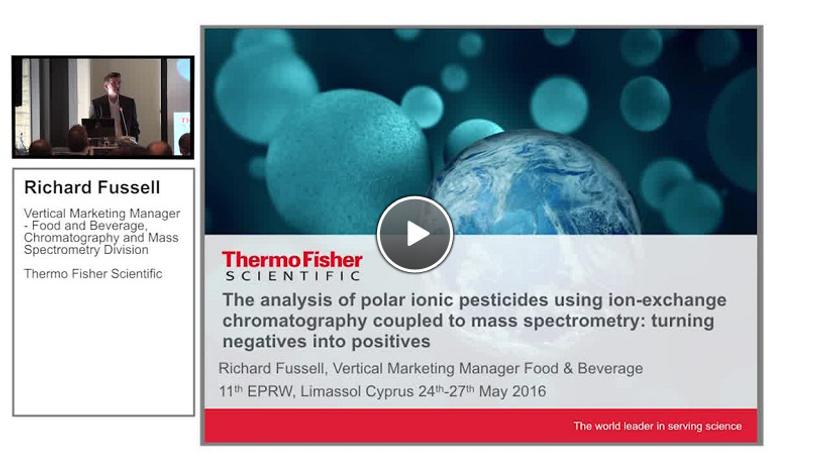Robust Analysis of Polar Ionic Pesticides using Ion-Exchange Chromatography Coupled to Mass Spectrometry
In a presentation recorded at EPRW, Richard Fussell, Thermo Fisher Scientific, described how IC-MS can be used to overcome the difficulties encountered with the use of conventional chromatographic methods for the analysis of polar ionic pesticides
11 Nov 2016

Polar ionic pesticides are widely used in agriculture. The frequent occurrence of residues in foodstuffs often generates heightened media attention, Richard explains. Ion-Exchange Chromatography Coupled to Mass Spectrometry (IC-MS), compared to conventional methods, offers a more effective option for the analysis of polar ionic pesticides.
The Quick Polar Pesticides (QuPPe) Method is a commonly used technique that allows for the simultaneous analysis of a number of highly polar pesticides in samples of plant origin, Richard explains. It is a generic extraction, using acidified methanol, without clean-up, before measurement by LC-MS. The method was developed in Stuttgart by the European Reference Laboratory (EURL) for Single Residue Methods. He describes that the method is not perfect, as ‘dirty’ extracts, containing a high concentration of sample co-extractives, contaminate the columns and MS systems relatively quickly. This in-turn causes variations in retention times, recoveries and precision. However, Richard also acknowledges that the QuPPe method is more cost effective than previous processes requiring derivatization, and has at least encouraged analysts to attempt the analysis of pesticides that were hardly ever monitored before.
How IC-MS/MS can help
Richard states that polar ionic pesticides, due to their charged nature, are difficult to extract and chromatograph using conventional techniques. To address this issue, Thermo Fisher Scientific partnered with Fera Science Ltd, UK, to develop an IC-MS multi-residue method for the analysis of polar pesticides in QuPPe extracts. Through this partnership, a study was conducted to evaluate the Thermo Scientific™ TSQ Quantiva™ Triple Quadrupole Mass Spectrometer in conjunction with the Thermo Scientific™ Dionex™ ICS-5000+. The use of new HPIC™ IC column technology combined with an ultra-sensitive triple quadrupole mass spectrometer, provided much improved results compared to those generated using older systems, he explains.
A noticeable advancement from previous methods is the reduction in amount of sample injected on-column. Furthermore, the chromatographic peak shapes at low concentrations, typically 10 ng/g, were better and hence the signal-to-noise ratio much improved. The smaller amount of sample injected on-column allowed more analyses to be carried out before the IC columns required cleaning, thus improving the efficiency of the whole workflow.
Richard reports that development is still under way, as the method has presently only been validated for 13 polar anionic pesticides, including glyphosate, glufosinate, ethephon, fosetyl aluminium and their metabolites, as well as chlorate and perchlorate. Also, he alluded to the fact that preliminary results for both, the analysis of cationic pesticides, and the use of IC coupled Orbitrap technology for the analysis of polar ionic pesticides, show much promise for the future.
